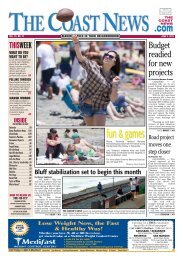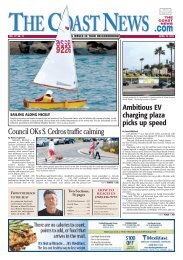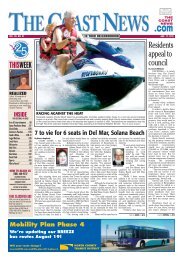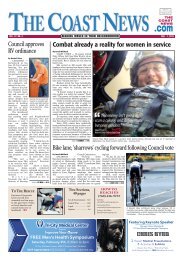Create successful ePaper yourself
Turn your PDF publications into a flip-book with our unique Google optimized e-Paper software.
A10 THE COAST NEWS<br />
DEC. 16, 2011<br />
Exposing the little known side of onshore photography<br />
Clark Little was not the<br />
first surf photographer to be<br />
fascinated by waves breaking<br />
in the shore break. I<br />
recall Surfer Magazine photographer<br />
Woody Woodworth<br />
in the mid ‘70s spending<br />
hours shooting 6-inch waves<br />
lapping the shore in Baja,<br />
stoked at the color and the<br />
symmetry of mirco waves.<br />
Local surf photographer<br />
Rob Gilley has also taken<br />
some stunning images of the<br />
shore break. Still, to my<br />
knowledge, nobody has specialized<br />
in photographing<br />
the waves that break on<br />
shore the way Clark Little<br />
does. <strong>The</strong>y rank among the<br />
most interesting surf shots I<br />
have ever seen.<br />
As a surfer, I am like<br />
CHRIS<br />
AHRENS<br />
Sea Notes<br />
most of you. I want to get out<br />
past the shore break as<br />
quickly as possible in order<br />
to ride bigger waves, breaking<br />
in deeper water.<br />
But it is here, right<br />
where the water meets the<br />
sand, that some of the most<br />
beautifully violent fractions<br />
of seconds occur.<br />
Most people don’t want<br />
to loiter long amid that violent<br />
impact with an expensive<br />
camera, but that’s where<br />
Little’s most famous photos<br />
are taken.<br />
So now I’m a few hundred<br />
words short of a thousand<br />
trying to convey the<br />
beauty of a world that needs<br />
to be seen to be believed.<br />
Even then you might think<br />
this isn’t happening on<br />
beaches you’re familiar with,<br />
but on some distant planet.<br />
In Little’s world waves<br />
behave unpredictably, rising<br />
up in defiance before spending<br />
themselves on shore, or<br />
throwing out impossibly far<br />
in what look to be ice caves.<br />
Vivid blues and other colors,<br />
some beyond description,<br />
bend into transparent caverns,<br />
a gem show often lasting<br />
less than a second. Click.<br />
An aquatic version of the<br />
Northern Lights explode in a<br />
North Shore sunset, warped<br />
beyond recognition after<br />
being filtered through a thin<br />
sheet of barreling clear<br />
water.<br />
<strong>The</strong>se technical feats<br />
attest to beauty that few<br />
have ever seen, although it’s<br />
right in front of us.<br />
While these beautiful<br />
shots can rock us gently into<br />
dreamland, much of Little’s<br />
other work attest to the violence<br />
committed on the<br />
beach.<br />
<strong>The</strong>re are massive<br />
chunks of potentially deadly<br />
water throwing out at Sandy<br />
Beach, where a bodyboarder<br />
slides down a 10-foot water<br />
slide onto a bed of hard<br />
sand. Waimea Bay is arrested<br />
in the act of condensing and<br />
pouring super bowl sized<br />
buckets onto the land.<br />
How is it that nobody<br />
died? Empty barrels grind<br />
like cement mixers about to<br />
By Bianca Kaplanek<br />
SOLANA BEACH —<br />
With the U.S. Army Corps of<br />
Engineers considering a pilot<br />
plan to install an artificial off<br />
the coast of Fletcher Cove,<br />
the city held an informational<br />
meeting Dec. 7 to discuss the<br />
status and future of the project.<br />
Approximately two<br />
dozen stakeholders, including<br />
city staff, residents, surfers,<br />
environmentalists and engineers,<br />
attended the threehour<br />
discussion led by<br />
Richard Seymour, head of<br />
coastal engineering at<br />
Scripps Institution of<br />
Oceanography at the<br />
University of California San<br />
Diego.<br />
<strong>The</strong> roundtable workshop<br />
included a brief history<br />
Clark Little’s “Mohawk.” Photo by ClarkLittle.com<br />
explode before disappearing<br />
into nothing. For those not<br />
familiar with Oahu’s powerful<br />
ocean, getting this close<br />
is an invitation to a broken<br />
neck.<br />
Our planet is portrayed<br />
as an aquatic destruction<br />
derby before Clark again<br />
switches gears and lets us<br />
and allowed participants to<br />
share what they thought were<br />
the challenges and benefits of<br />
the reef.<br />
After soliciting proposals<br />
for shoreline protection, the<br />
Army Corps of Engineers<br />
selected Solana Beach and<br />
funding was provided in 2006.<br />
<strong>The</strong> main goal is to create<br />
a multipurpose reef to<br />
retain sand and stabilize the<br />
shoreline. Secondary objectives<br />
are to provide biological<br />
value and enhance recreational<br />
uses, including surfing.<br />
According to a March<br />
2010 conceptual design<br />
report prepared by Everest<br />
International Consultants<br />
Inc. for the Army Corps and<br />
Solana Beach, the city’s entire<br />
shoreline experiences dam-<br />
easily down into a pool of<br />
shallow water where a<br />
friendly looking sea turtle<br />
glides through a subterranean<br />
Hawaiian garden.<br />
<strong>The</strong> lesson I took from<br />
Clark Little’s photographs is<br />
that deadly and benign<br />
beauty is all around us if we<br />
take the time to look a little<br />
age by waves during storms<br />
that have caused “significant<br />
recreational beach loss,”<br />
threatening public safety and<br />
the stability of surrounding<br />
public and private structures.<br />
A stabilization structure<br />
such as a multipurpose reef<br />
could retain sediment, reduce<br />
storm damage and beach loss<br />
and maximize the benefits of<br />
ongoing and future beach<br />
nourishment projects, the<br />
report stated.<br />
That report, considered<br />
phase one, modified the<br />
design of a conceptual structure<br />
in Ventura County to<br />
local conditions. It also evaluated<br />
the sand retention ability<br />
of an artificial, submerged<br />
offshore reef and developed<br />
and evaluated alternatives.<br />
Phase two would include<br />
a detailed design and environmental<br />
studies that would<br />
evaluate the shoreline change<br />
and the effects on surf and<br />
other recreational activities,<br />
habitat and potential sea<br />
level rise.<br />
Phases three through<br />
five would include engineering<br />
plans, permitting, construction<br />
and post-construction<br />
monitoring.<br />
In a best-case scenario,<br />
the reef could be installed in<br />
five years, but Bob Hoffman<br />
from the U.S. Fish and<br />
Wildlife Service called that<br />
estimate “very optimistic”<br />
since funding is currently not<br />
available for phase two and<br />
beyond.<br />
<strong>The</strong> entire project is estimated<br />
to cost between $3 mil-<br />
deeper.<br />
To look deeper into<br />
Clark Little’s word, visit<br />
clarklittlephotography.com.<br />
You’ll never view the shore<br />
break the same again.<br />
Chris Ahrens is a surfer and author of<br />
four books on surfing. E-mail him at<br />
cahrens@coastnewsgroup.com.<br />
Stakeholders hold talks on offshore reef<br />
lion and $8 million. So far the<br />
city has spent $20,000 and<br />
another $100,000 came from a<br />
federal grant, City Manager<br />
David Ott said.<br />
<strong>The</strong> city retained<br />
Seymour earlier this year to<br />
review the reports conducted<br />
so far.<br />
Representatives from the<br />
Surfrider Foundation had<br />
issues about building the reef<br />
out of plastic given the current<br />
drive to keep that material<br />
out of the ocean.<br />
<strong>The</strong>re were also concerns<br />
about the cost and possible<br />
environmental hazards if the<br />
structure had to be removed.<br />
“Anything you put in the<br />
ocean you may have to<br />
remove,” one participant said.<br />
“And removal is a very real<br />
possibility with a moving<br />
shoreline so it has to be able<br />
to be removed.”<br />
Other challenges would<br />
be keeping the structure submerged<br />
during low tides and<br />
making it look natural.

















